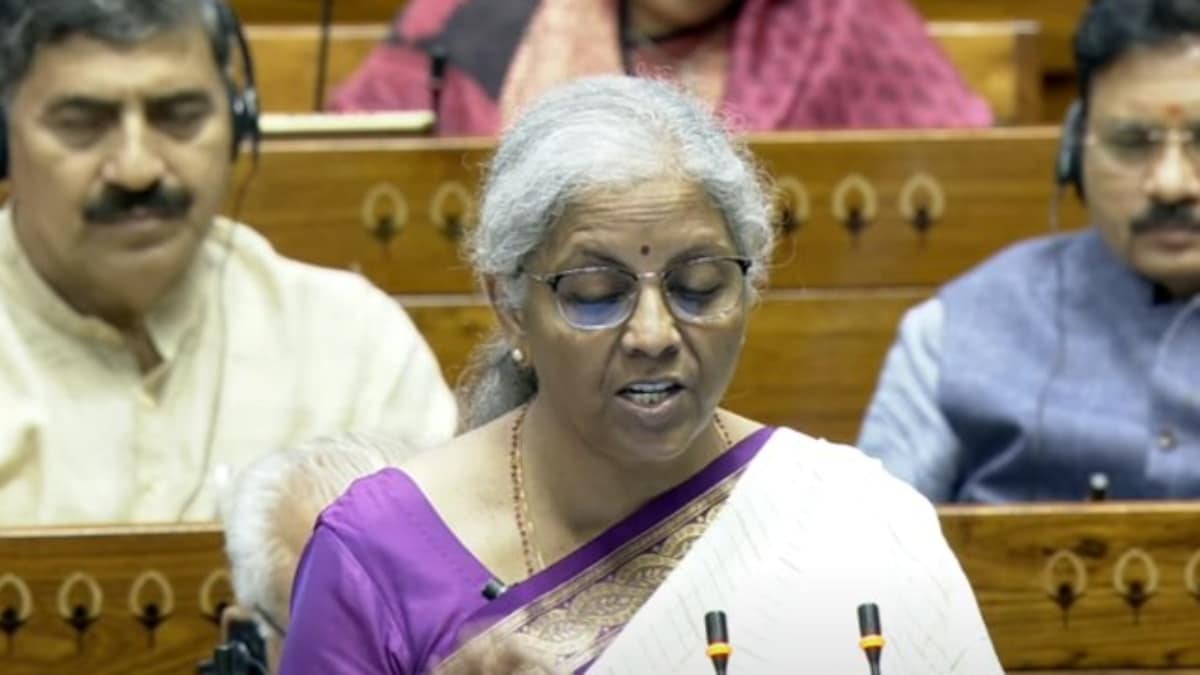Presenting the first Union Budget of Modi 3.0, Union Finance Minister Nirmala Sitharaman focused on job creation, infrastructure development, making new regime of personal income tax more attractive, increasing the standard deduction limits for income tax payers giving a boost to startups with measures such as the abolition of angel tax, and special financial assistance in terms of investment in Bihar and Andhra Pradesh, two states ruled by the Bharatiya Janata Party’s allies — the Janata Dal-United and the Telugu Desam Party respectively — which are crucial for the stability of the National Democratic Alliance government of Prime Minister Narendra Modi at the Centre. Here is Nirmala Sitharaman’s full speech that she gave earlier in the Lok Sabha: Hon’ble Speaker, I present the Budget for 2024-25.
Introduction Global Context The global economy, while performing better than expected, is still in the grip of policy uncertainties. Elevated asset prices, political uncertainties and shipping disruptions continue to pose significant downside risks for growth and upside risks to inflation. In this context, India’s economic growth continues to be the shining exception and will remain so in the years ahead.

India’s inflation continues to be low, stable and moving towards the 4 per cent target. Core inflation (non-food, non-fuel) currently is 3.1 per cent.
Steps are being taken to ensure supplies of perishable goods reach market adequately. Interim Budget As mentioned in the interim budget, we need to focus on 4 major castes, namely ‘Garib’ (Poor), ‘Mahilayen’ (Women), ‘Yuva’ (Youth) and ‘Annadata’ (Farmer). For Annadata, we announced higher Minimum Support Prices a month ago for all major crops, delivering on the promise of at least a 50 per cent margin over costs.
Pradhan Mantri Garib Kalyan Anna Yojana was extended for five years, benefitting more than 80 crore people. Administrative actions for approval and implementation of various schemes announced in the interim budget are well underway. The required allocations have been made.
Budget Theme Budget Priorities 1)Productivity and resilience in Agriculture 2)Employment & Skilling 3)Inclusive Human Resource Development and Social Justice 4)Manufacturing & Services 5)Urban Development 6)Energy Security 7)Infrastructure 8)Innovation, Research & Development and 9) Next Generation Reforms Subsequent budgets will build on these, and add more priorities and actions. A more detailed formulation will be carried out as part of the ‘economic policy framework’ about which I will speak later in this speech. This budget details some of the specific actions to be initiated in the current year towards fulfillment of these priorities with potential for transformative changes.
The budget also covers some of the previously made announcements with an intent to strengthen them and step up their implementation for expediting our journey towards the goal of Viksit Bharat. Priority 1: Productivity and resilience in Agriculture Transforming agriculture research Release of new varieties Natural Farming Missions for pulses and oilseeds Vegetable production & Supply Chains Digital Public Infrastructure for Agriculture Shrimp Production & Export National Cooperation Policy Our government will bring out a National Cooperation Policy for systematic, orderly and all-round development of the cooperative sector. Fast-tracking growth of rural economy and generation of employment opportunities on a large scale will be the policy goal.
This year, I have made a provision of ` 1.52 lakh crore for agriculture and allied sector. Priority 2: Employment & Skilling Employment Linked Incentive Scheme A: First Timers Scheme B: Job Creation in manufacturing Scheme C: Support to employers Participation of women in the workforce Skilling programme Skilling Loans Education Loans Priority 3: Inclusive Human Resource Development and Social Justice Saturation approach Our government is committed to all-round, all-pervasive and all-inclusive development of people, particularly, farmers, youth, women and poor.
For achieving social justice comprehensively, the saturation approach of covering all eligible people through various programmes including those for education and health will be adopted to empower them by improving their capabilities. Implementation of schemes meant for supporting economic activities by craftsmen, artisans, self-help groups, scheduled caste, schedule tribe and women entrepreneurs, and street vendors, such as PM Vishwakarma, PM SVANidhi, National Livelihood Missions, and Stand-Up India will be stepped up. Purvodaya The states in the Eastern part of the country are rich in endowments and have strong cultural traditions.
We will formulate a plan, Purvodaya, for the all-round development of the eastern region of the country covering Bihar, Jharkhand, West Bengal, Odisha and Andhra Pradesh. This will cover human resource development, infrastructure, and generation of economic opportunities to make the region an engine to attain Viksit Bharat. On the Amritsar Kolkata Industrial Corridor, we will support development of an industrial node at Gaya.
This corridor will catalyze industrial development of the eastern region. The industrial node at Gaya will also be a good model for developing our ancient centres of cultural importance into future centres of modern economy. This model shall showcase “Vikas bhi Virasat bhi” in our growth trajectory.
We will also support development of road connectivity projects, namely (1) Patna-Purnea Expressway, (2) Buxar-Bhagalpur Expressway, (3) Bodhgaya, Rajgir, Vaishali and Darbhanga spurs, and (4) additional 2-lane bridge over river Ganga at Buxar at a total cost of 26,000 crore. Power projects, including setting up of a new 2400 MW power plant at Pirpainti, will be taken up at a cost of 21,400 crore. New airports, medical colleges and sports infrastructure in Bihar will be constructed.
An additional allocation to support capital investments will be provided. The requests of Bihar Government for external assistance from multilateral development banks will be expedited. Andhra Pradesh Reorganization Act Our government has made concerted efforts to fulfil the commitments in the Andhra Pradesh Reorganization Act.
Recognizing the state’s need for a capital, we will facilitate special financial support through multilateral development agencies. In the current financial year ` 15,000 crore will be arranged, with additional amounts in future years. Our government is fully committed to financing and early completion of the Polavaram Irrigation Project, which is the lifeline for Andhra Pradesh and its farmers.
This will facilitate our country’s food security as well. Under the Act, for promoting industrial development, funds will be provided for essential infrastructure such as water, power, railways and roads in Kopparthy node on the Vishakhapatnam-Chennai Industrial Corridor and Orvakal node on Hyderabad-Bengaluru Industrial Corridor. An additional allocation will be provided this year towards capital investment for economic growth.
Grants for backward regions of Rayalaseema, Prakasam and North Coastal Andhra, as stated in the Act, will also be provided. PM Awas Yojana Women-led development Pradhan Mantri Janjatiya Unnat Gram Abhiyan Bank branches in North-Eastern Region More than 100 branches of India Post Payment Bank will be set up in the North East region to expand the banking services. This year, I have made a provision of ` 2.
66 lakh crore for rural development including rural infrastructure. Priority 4: Manufacturing & Services, Support for promotion of MSMEs Credit Guarantee Scheme for MSMEs in the Manufacturing Sector New assessment model for MSME credit Credit Support to MSMEs during Stress Period Mudra Loans Enhanced scope for mandatory onboarding in TReDS SIDBI branches in MSME clusters MSME Units for Food Irradiation, Quality & Safety Testing E-Commerce Export Hubs Measures for promotion of Manufacturing & Services, Internship in Top Companies Industrial Parks Our government will facilitate development of investment-ready “plug and play” industrial parks with complete infrastructure in or near 100 cities, in partnership with the states and private sector, by better using town planning schemes. Twelve industrial parks under the National Industrial Corridor Development Programme also will be sanctioned.
Rental Housing Shipping industry Critical Mineral Mission Offshore mining of minerals Digital Public Infrastructure Applications Integrated Technology Platform for IBC eco-system Voluntary closure of LLPs National Company Law Tribunals The IBC has resolved more than 1,000 companies, resulting in direct recovery of over 3.3 lakh crore to creditors. In addition, 28,000 cases involving over 10 lakh crore have been disposed of, even prior to admission.
Appropriate changes to the IBC, reforms and strengthening of the tribunal and appellate tribunals will be initiated to speed up insolvency resolution. Additional tribunals will be established. Out of those, some will be notified to decide cases exclusively under the Companies Act.
Debt Recovery Priority 5: Urban Development Cities as Growth Hubs Creative redevelopment of cities Transit Oriented Development Urban Housing Under the PM Awas Yojana Urban 2.0, housing needs of 1 crore urban poor and middle-class families will be addressed with an investment of ₹ 10 lakh crore. This will include the central assistance of ₹ 2.
2 lakh crore in the next 5 years. A provision of interest subsidy to facilitate loans at affordable rates is also envisaged. In addition, enabling policies and regulations for efficient and transparent rental housing markets with enhanced availability will also be put in place.
Water Supply and Sanitation Street Markets Stamp Duty Priority 6: Energy Security, Energy Transition PM Surya Ghar Muft Bijli Yojana Pumped Storage Policy Research and development of small and modular nuclear reactors Advanced Ultra Super Critical Thermal Power Plants Roadmap for ‘hard to abate’ industries Support to traditional micro and small industries Priority 7: Infrastructure, Infrastructure investment by central government Infrastructure investment by state governments Private investment in infrastructure Pradhan Mantri Gram Sadak Yojana (PMGSY) Irrigation and Flood Mitigation Bihar has frequently suffered from floods, many of them originating outside the country. Plans to build flood control structures in Nepal are yet to progress. Our government, through the Accelerated Irrigation Benefit Programme and other sources, will provide financial support for projects with estimated cost of ` 11,500 crore such as the Kosi-Mechi intra-state link and 20 other ongoing and new schemes including barrages, river pollution abatement and irrigation projects.
In addition, survey and investigation of Kosi related flood mitigation and irrigation projects will be undertaken. Assam grapples with floods every year by the Brahmaputra River and its tributaries, originating outside India. We will provide assistance to Assam for flood management and related projects.
Himachal Pradesh suffered extensive losses due to floods last year. Our government will provide assistance to the state for reconstruction and rehabilitation through multilateral development assistance. Uttarakhand too suffered losses due to cloud bursts and massive landslides.
We will provide assistance to the state. Recently Sikkim witnessed devastating flash floods and landslides that wreaked havoc across the state. Our Government will provide assistance to the state.
Tourism Tourism has always been a part of our civilization. Our efforts in positioning India as a global tourist destination will also create jobs, stimulate investments and unlock economic opportunities for other sectors. In addition to the measures outlined in the interim budget, I propose the following measures.
Vishnupad Temple at Gaya and Mahabodhi Temple at Bodh Gaya in Bihar are of immense spiritual significance. Comprehensive development of Vishnupad Temple Corridor and Mahabodhi Temple Corridor will be supported, modelled on the successful Kashi Vishwanath Temple Corridor, to transform them into world class pilgrim and tourist destinations. Rajgir holds immense religious significance for Hindus, Buddhists and Jains.
The 20th Tirthankara Munisuvrata temple in the Jain Temple complex is ancient. The Saptharishi or the 7 hotsprings form a warm water Brahmakund that is sacred. A comprehensive development initiative for Rajgir will be undertaken.
Our government will support the development of Nalanda as a tourist centre besides reviving Nalanda University to its glorious stature. Odisha’s scenic beauty, temples, monuments, craftsmanship, wildlife sanctuaries, natural landscapes and pristine beaches make it an ultimate tourism destination. Our government will provide assistance for their development.
Priority 8: Innovation, Research & Development Space Economy Priority 9: Next Generation Reforms, Economic Policy Framework We will formulate an Economic Policy Framework to delineate the overarching approach to economic development and set the scope of the next generation of reforms for facilitating employment opportunities and sustaining high growth. Our government will initiate and incentivize reforms for (1) improving productivity of factors of production, and (2) facilitating markets and sectors to become more efficient. These reforms will cover all factors of production, namely land, labour, capital and entrepreneurship, and technology as an enabler of improving total factor productivity and bridging inequality.
Effective implementation of several of these reforms requires collaboration between the Centre and the states and building consensus, as development of the country lies in development of the states. For promoting competitive federalism and incentivizing states for faster implementation of reforms, I propose to earmark a significant part of the 50-year interest-free loan. Working with the states, we will initiate the following reforms.
Land-related reforms by state governments Rural Land related actions Urban Land related actions Labour related reforms, Services to Labour Shram Suvidha & Samadhan Portal Capital and entrepreneurship related reforms, Financial sector vision and strategy Taxonomy for climate finance Variable Capital Company structure Foreign Direct Investment and Overseas Investment NPS Vatsalya Use of Technology Ease of Doing Business Data and Statistics New Pension Scheme (NPS) Budget Estimates 2024-25 For the year 2024-25, the total receipts other than borrowings and the total expenditure are estimated at 32.07 lakh crore and 48.21 lakh crore respectively.
The net tax receipts are estimated at ` 25.83 lakh crore. The fiscal deficit is estimated at 4.
9 per cent of GDP. The gross and net market borrowings through dated securities during 2024-25 are estimated at 14.01 lakh crore and 11.
63 lakh crore respectively. Both will be less than that in 2023-24. The fiscal consolidation path announced by me in 2021 has served our economy very well, and we aim to reach a deficit below 4.
5 per cent next year. The Government is committed to staying the course. From 2026-27 onwards, our endeavour will be to keep the fiscal deficit each year such that the Central Government debt will be on a declining path as percentage of GDP.
I will, now, move to Part B. PART B, Indirect Taxes I start with GST. It has decreased tax incidence on the common man; reduced compliance burden and logistics cost for trade and industry; and enhanced revenues of the central and state governments.
It is a success of vast proportions. To multiply the benefits of GST, we will strive to further simplify and rationalise the tax structure and endeavour to expand it to the remaining sectors. My proposals for customs duties intend to support domestic manufacturing, deepen local value addition, promote export competitiveness, and simplify taxation, while keeping the interest of the general public and consumers surmount.
In Budget 2022-23, we reduced the number of customs duty rates. I propose to undertake a comprehensive review of the rate structure over the next six months to rationalise and simplify it for ease of trade, removal of duty inversion and reduction of disputes. I shall now take up sector specific customs duty proposals.
Medicines and Medical Equipment To provide relief to cancer patients, I propose to fully exempt three more medicines from customs duties. I also propose changes in the BCD on x-ray tubes & flat panel detectors for use in medical x-ray machines under the Phased Manufacturing Programme, so as to synchronise them with domestic capacity addition. Mobile Phone and Related Parts Critical Minerals Solar Energy Marine products Leather and Textile Similarly, to enhance the competitiveness of exports in the leather and textile sectors, I propose to reduce BCD on real down filling material from duck or goose.
I am also making additions to the list of exempted goods for manufacture of leather and textile garments, footwear and other leather articles for export. To rectify inversion in duty, I propose to reduce BCD, subject to conditions, on methylene diphenyl diisocyanate (MDI) for manufacture of spandex yarn from 7.5 to 5 per cent.
Furthermore, the export duty structure on raw hides, skins and leather is proposed to be simplified and rationalized. Precious Metals Other Metals Electronics Chemicals and Petrochemicals Plastics Telecommunication Equipment Trade facilitation Direct Taxes We will continue our efforts to simplify taxes, improve tax payer services, provide tax certainty and reduce litigation while enhancing revenues for funding the development and welfare schemes of the government. Comprehensive Review of the Income-tax Act, 1961 I am now announcing a comprehensive review of the Income-tax Act, 1961.
The purpose is to make the Act concise, lucid, easy to read and understand. This will reduce disputes and litigation, thereby providing tax certainty to the tax payers. It will also bring down the demand embroiled in litigation.
It is proposed to be completed in six months. A beginning is being made in the Finance Bill by simplifying the tax regime for charities, TDS rate structure, provisions for reassessment and search provisions and capital gains taxation. Simplification for Charities and of TDS Simplification of Reassessment Simplification and Rationalisation of Capital Gains Capital gains taxation is also proposed to be hugely simplified.
Short term gains on certain financial assets shall henceforth attract a tax rate of 20 per cent, while that on all other financial assets and all non-financial assets shall continue to attract the applicable tax rate. Long term gains on all financial and non-financial assets, on the other hand, will attract a tax rate of 12.5 per cent.
For the benefit of the lower and middle-income classes, I propose to increase the limit of exemption of capital gains on certain financial assets to ₹ 1.25 lakh per year. Listed financial assets held for more than a year will be classified as long term, while unlisted financial assets and all non-financial assets will have to be held for at least two years to be classified as long-term.
Unlisted bonds and debentures, debt mutual funds and market linked debentures, irrespective of holding period, however, will attract tax on capital gains at applicable rates. Tax Payer Services Litigation and Appeals While our concerted efforts to reduce pendency of appeals at various appellate fora are beginning to show good results, it will continue to engage our highest attention. To dispose of the backlog of first appeals, I plan to deploy more officers to hear and decide such appeals, especially those with large tax effect.
For resolution of certain income tax disputes pending in appeal, I am also proposing Vivad Se Vishwas Scheme, 2024. Further, I propose to increase monetary limits for filing appeals related to direct taxes, excise and service tax in the Tax Tribunals, High Courts and Supreme Court to ₹ 60 lakh, ₹ 2 crore and ₹ 5 crore respectively. With a view to reduce litigation and provide certainty in international taxation, we will expand the scope of safe harbour rules and make them more attractive.
We will also streamline the transfer pricing assessment procedure. Employment and Investment I have a few proposals to promote investment and foster employment. First of all, to bolster the Indian start-up eco-system, boost the entrepreneurial spirit and support innovation, I propose to abolish the so-called angel tax for all classes of investors.
Second, there is tremendous potential for cruise tourism in India. To give a fillip to this employment generating industry, I am proposing a simpler tax regime for foreign shipping companies operating domestic cruises in the country. Third, India is a world leader in the diamond cutting and polishing industry, which employs a large number of skilled workers.
To further promote the development of this sector, we would provide for safe harbour rates for foreign mining companies selling raw diamonds in the country. Fourth, to attract foreign capital for our development needs, I propose to reduce the corporate tax rate on foreign companies from 40 to 35 per cent. Deepening the tax base Others To improve social security benefits, deduction of expenditure by employers towards NPS is proposed to be increased from 10 to 14 per cent of the employee’s salary.
Similarly, deduction of this expenditure up to 14 per cent of salary from the income of employees in private sector, public sector banks and undertakings, opting for the new tax regime, is proposed to be provided. Indian professionals working in multinationals get ESOPs and invest in social security schemes and other movable assets abroad. Non-reporting of such small foreign assets has penal consequences under the Black Money Act.
Such non-reporting of movable assets up to ₹ 20 lakh is proposed to be de-penalised. Other major proposals in the Finance Bill relate to: Withdrawal of equalization levy of 2 per cent; Expansion of tax benefits to certain funds and entities in IFSCs; and immunity from penalty and prosecution to benamidar on full and true disclosure so as to improve conviction under the Benami Transactions (Prohibition) Act, 1988. Personal Income Tax Coming to Personal Income Tax Rates, I have two announcements to make for those opting for the new tax regime.
First, the standard deduction for salaried employees is proposed to be increased from ₹50,000/- to ₹75,000/-. Similarly, deduction on family pension for pensioners is proposed to be enhanced from ₹ 15,000/- to ₹ 25,000/-. This will provide relief to about four crore salaried individuals and pensioners.
Second, in the new tax regime, the tax rate structure is proposed to be revised, as follows: As a result of these changes, a salaried employee in the new tax regime stands to save up to ₹ 17,500/- in income tax. Apart from these, I am also making some other changes as given in the annexure. As a result of these proposals, revenue of about ₹ 37,000 crore – ₹ 29,000 crore in direct taxes and ₹ 8,000 crore in indirect taxes – will be forgone while revenue of about ₹ 30,000 crore rupees will be additionally mobilized.
Thus, the total revenue forgone is about ₹ 7,000 crore annually. Mr. Speaker Sir, with this, I commend the budget to this august House.
Jai Hind..



















